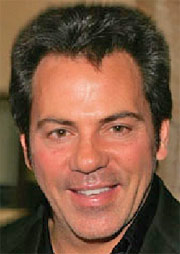Analysts are digging into the new owners of the San Diego Union-Tribune and trying to discern the investment firm’s intentions.
Sign-on San Diego fills in some of the information void surrounding Platinum Equity, the purchase of the site’s parent. Despite its low public profile, the company is actually the 19th largest private employer in the US, according to a Forbes estimate. Its founder, Tom Gores (right), has been listed by Forbes as the 163rd-richest American, with a net worth of $2.5 billion. It raised $2.75 billion last year – which was quite a feat in this economy – for its investment activities. The U-T is the first newspaper the company has owned but it may not be the last. There have been media reports that the principals are also looking at the Austin American-Statesman. Most importantly for U-T employees, the story quotes Platinum principal Mark Barnhill saying Platinum isn’t in the game for a quick flip. “We don’t worry about exits,” Barnhill says. “We worry about getting in on the entry side and running businesses effectively.”
Ken Doctor isn’t so sure. In his view, the deal may be all about the real estate. Citing sources who say Platinum paid no more than $50 million for the U-T, whose value once exceeded a half billion dollars, Doctor says the value of the land alone could be north of $100 million. “We may have entered a new rocky period for newspaper companies,” he writes. “The real estate on which they sit determines their market value.” Doctor notes that the biggest buyout in the history of the industry – the acquisition of Tribune Co. in 2007 – was carried out by a real estate tycoon. And property is part of the value that investors are scrutinizing carefully in Miami and Maine.
Writing on Paid Content, Doctor observes that Platinum Equity specializes in high-tech companies, so what’s it doing with a newspaper? The strategic adviser the partners are bringing in – David Black – has done nothing of note with the Akron Beacon-Journal that he took over in 2006. “The Black ownership has been unremarkable,” Doctor writes. So what did Platinum buy? Property “That real estate under its building…may be a real motivator for the purchase,” he concludes.
Incidentally, Ken Doctor has an interview with Michelle Nicolosi, who’s the editor in charge of turning SeattlePI.com into a true Web publisher. She’s trying to boost the idea of aggregation and local focus, but Doctor points out that links to direct competitors are pretty thin in the first week. The collection of 150 reader blogs is impressive, though.
Power in the Mid-Market
 The Deal Journal blog at WSJ.com has an intriguing interview with Jonathan Knee, an investment banker who specializes in the media industry and who advised on the U-T buy. He has some intriguing insights that go well beyond the “industry is dying” conventional wisdom. Working from the premise that “within the pantheon of media sectors, the newspaper business is actually still one of the better ones,” Knee argues that the bloated cost structures that newspapers developed during times of plenty actually make them good candidates to endure the cost cuts they’re having to make right now, simply because there’s so much excess to cut. Furthermore, he argues, mid-market dailies are actually in a great position to harvest their monopoly positions and remain profitable for some time to come.
The Deal Journal blog at WSJ.com has an intriguing interview with Jonathan Knee, an investment banker who specializes in the media industry and who advised on the U-T buy. He has some intriguing insights that go well beyond the “industry is dying” conventional wisdom. Working from the premise that “within the pantheon of media sectors, the newspaper business is actually still one of the better ones,” Knee argues that the bloated cost structures that newspapers developed during times of plenty actually make them good candidates to endure the cost cuts they’re having to make right now, simply because there’s so much excess to cut. Furthermore, he argues, mid-market dailies are actually in a great position to harvest their monopoly positions and remain profitable for some time to come.
The secret: outsource whatever isn’t necessary to serve your local community. Then serve that local community very well. Don’t try to be bigger than what you are. Those boring local markets will “continue to generate…better profits than the supersexy businesses in the media industry asking for government or nonprofit help like movies and music.” Considering that small-market dailies have been considered the most at-risk properties in the business, Knee’s counter-intuitive views are worth reading.
Happy Birthday to Us
 Today is Newspaper Death Watch’s second birthday (you can read our modest first entry here) and it’s been quite a ride. We started out by documenting the downsizing that was just beginning to occur in the business two years ago but quickly found ourselves engaged in more interesting issues like the future of news. Since 3/23/07 we’ve logged 382 entries and 528 comments, many from journalists who are being caught up in the cost-cutting. Last week we averaged over 2,000 daily page views and Technorati has us in the top 12,000 blogs worldwide. We’ve been profiled in Spain’s largest newspaper, interviewed on NPR, traded views with Guardian Angels founder Curtis Sliwa on talk radio, and sourced on local TV in Sacramento. We were also just interviewed by CNN.com for an upcoming feature on the transformation in the newspaper industry.
Today is Newspaper Death Watch’s second birthday (you can read our modest first entry here) and it’s been quite a ride. We started out by documenting the downsizing that was just beginning to occur in the business two years ago but quickly found ourselves engaged in more interesting issues like the future of news. Since 3/23/07 we’ve logged 382 entries and 528 comments, many from journalists who are being caught up in the cost-cutting. Last week we averaged over 2,000 daily page views and Technorati has us in the top 12,000 blogs worldwide. We’ve been profiled in Spain’s largest newspaper, interviewed on NPR, traded views with Guardian Angels founder Curtis Sliwa on talk radio, and sourced on local TV in Sacramento. We were also just interviewed by CNN.com for an upcoming feature on the transformation in the newspaper industry.
Two years ago, we published a book called The New Influencers that argued that the ability of individuals to publish to a global audience would disrupt the economics of media and transform our institutions. Since then, we’ve been living that idea.
Layoff Log
- Collateral damage: the Denver Newspaper Agency, which handled business operations for both the Post and the Rocky Mountain News, will idle 200 people as a result of the Rocky‘s closure. The news account says that’s 17% of the agency’s 850-person staff, but our calculator says it’s really 23%. The jobs aren’t needed any more without a paper to support.
- I turns out he Buffalo News won’t be laying off “dozens of employees” as ws feared a week ago. A deal with the Newspaper Guild succeeds in achieving targeted cuts of $2.9 million through a combination of wage reductions and givebacks. Still, nine people will lose their jobs.
- The Orange County Register had six rounds of layoffs last year and is promising more soon. No details on how many jobs will be lost.
- The Dayton Daily News cut 10 sales staff.
- The Skagit (Wash.) Valley Herald has laid off four people, including the editor-in-chief.
- The News-Gazette of central Illinois has been publishing both morning and afternoon editions on weekdays, but beginning June 1, it will publish ditch the afternoon edition. Elimination of an entire issue will save 1% in operating costs. Huh?
And Finally…
What would you do if your newspaper closed? Consider a career in local government. The New York Times profiles Michael Hanke, a veteran newspaperman from Canton, Ohio, who lovingly covered his hometown for more than 35 years before being laid off in a cost-cutting move two years ago. It could have been a sad story, but there’s a happy twist: Hanke is now a county administrator, where he works side-by-side with some of the people he used to criticize in his newspaper columns. And they’re tickled pink to work with him. It turns out that reporters are naturally inquisitive, resourceful and knowledgeable. “We got a real bargain when we hired Mike Hanke,” says Jane Vignos, the board president who selected him from among 70 candidates.
Comments
This entry was posted on Monday, March 23rd, 2009 at 8:00 am and is filed under Facebook, Fake News, Solutions. You can follow any responses to this entry through the RSS 2.0 feed. Both comments and pings are currently closed.




Has anyone now looked into the decline of the internet, as of recent weeks, many internet providers are showing a decline in activity since many Americans and now overseas are being hit with the recession.
Many people are cutting out expenses and the internet is one along with other household areas.
The library’s have gained increase usage do to this situation.